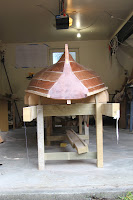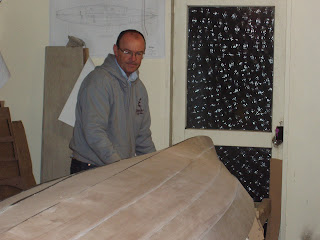Someone asked me last night - "what happens in the doldrums?" The answer is nothing.
 |
| Nothing happens |
A number of things have transpired to slow down progress on the boat.
- I've got a huge project on at work.
- Chris has been a bit "poorly"
- Chris has been working in the bay of islands, when he's not been "a bit poorly"
- My son broke his motorbike, so we've been replacing the engine.
- Its winter, the garage is cold.
So, call this blog a stopgap, our very own boat-building doldrums.
In the meantime, let me tell you about Harry's bike, it's a tale of bad luck and worse judgement.
Harry, last in line to the O'Neill hundreds, has been pestering for a scooter, I flatly refused. They are pathetic, dangerous and require no skill or training. I wasn't having it. I said, if you get a bike, you get one with gears that keeps up with the traffic and you get some training.
 |
| Going Nowhere. |
Having had his day with
Andrew Templeton, and got his license, we went on the hunt for a bike.
It transpired a guy at work was selling a GN250 - a very nice specimen too. (I think the GN stands for Go Nowhere). Here's a picture. So, I know the guy, and he gave me a very good deal, everyone was happy. Having got Harry kitted out in a load of expensive safety gear, I send him on his way.
Obviously, it all went horribly wrong, his bike broke and I had to buy a donor bike and replace the engine - to hear the full story, read the next bit. If you just want to know about the boat, and all things wood. Skip it.
For a few weeks, all goes well, and then Harry and a mate decide to go for a proper ride. To date, Harry has been riding too and from school, a mere 2 or 3 kilometers. Barely getting the engine warm, which, as you will see, is quite a telling point.
So, Harry and "bray-bray" ask me to recommend good ride. I tell them to go up the coast to the Pauatahanui inlet (pronounced in-let) and up over Paikakariki (pronounced pie-cock) hill. Apparently the ride went so well, that they decided not to take my advice and come back down SH1, but go back the way they came. About halfway up the hill, Harry noticed a distinct lack of Braden in his mirrors, a little bit worrying if you've been over Paikak hill, there are some rather terminal drop offs. So Harry goes back in search of a break in the No 8. safety barrier. It transpires it's just a petrol issue. So Braden gets on the back of Harry's bike and they go in search of fuel. A series of envents involving a lift with a policeman, an argument with a grumpy - no, you can't put petrol in a 2 ltr coke bottle - petrol station attendant ends with them back on the hill with darkness not far away. They decide to go back the short way.
5 minutes into the journey, just enough time to get onto the busiest bit of SH1, you know, the really narrow bit at Pukerua bay, everything stops on Harry's bike and he pulls over into the gutter. Numerous attempts to restart the bike failed, and I ended up driving up on a rescue mission. I used all my mechanical skills, which involved staring at the bike and scratching my head, to no avail and we hid the bike in the bushes and came home.
 |
| The view from Paekak hill, it really is worth breaking down for. |
Motor-Ad picked up the bike, and discovered that there was only 130mm of oil in the bike, it had run dry, over heated, gone blue and broke. Apparently you need 1.5 ltrs of oil, something we didn't check when we bought the bike. There is a school of thought that would suggest that when you buy a bike off a guy who says - it's serviced regularly and goes like a dream, you'd think it would have some oil in it. There is another school - buyer beware.
Harry and I now know how to buy a knackered bike with a good engine, remove and replace an engine, and most importantly, how much oil you need in a GN250. We now have -
- Really nice GN250 with a nice engine
- A knackered GN250 with a hole where the engine was.
- A GN250 engine with no bike, that rattles when you shake it.
And a half built boat.

















































